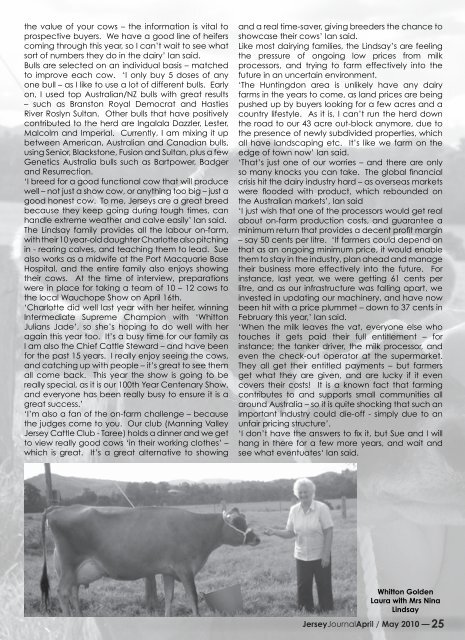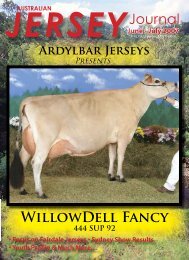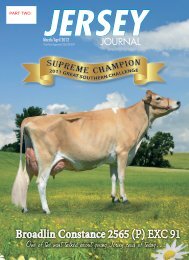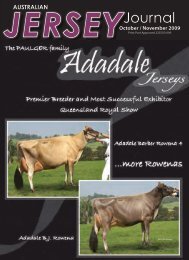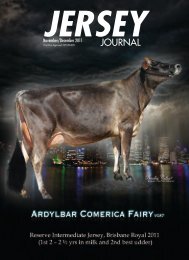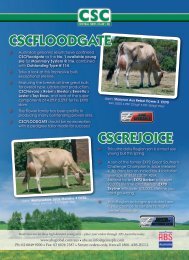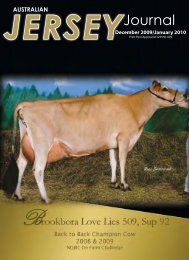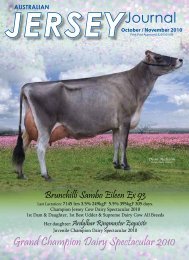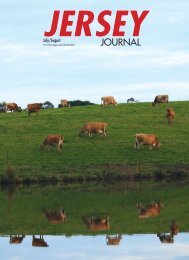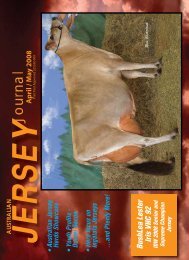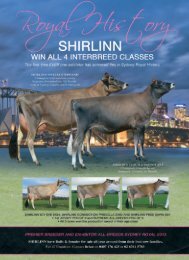April/May 2010 - Australian Jersey Breeders Society
April/May 2010 - Australian Jersey Breeders Society
April/May 2010 - Australian Jersey Breeders Society
You also want an ePaper? Increase the reach of your titles
YUMPU automatically turns print PDFs into web optimized ePapers that Google loves.
the value of your cows – the information is vital to<br />
prospective buyers. We have a good line of heifers<br />
coming through this year, so I can’t wait to see what<br />
sort of numbers they do in the dairy’ Ian said.<br />
Bulls are selected on an individual basis – matched<br />
to improve each cow. ‘I only buy 5 doses of any<br />
one bull – as I like to use a lot of different bulls. Early<br />
on, I used top <strong>Australian</strong>/NZ bulls with great results<br />
– such as Branston Royal Democrat and Hasties<br />
River Roslyn Sultan. Other bulls that have positively<br />
contributed to the herd are Ingalala Dazzler, Lester,<br />
Malcolm and Imperial. Currently, I am mixing it up<br />
between American, <strong>Australian</strong> and Canadian bulls,<br />
using Senior, Blackstone, Fusion and Sultan, plus a few<br />
Genetics Australia bulls such as Bartpower, Badger<br />
and Resurrection.<br />
‘I breed for a good functional cow that will produce<br />
well – not just a show cow, or anything too big – just a<br />
good honest cow. To me, <strong>Jersey</strong>s are a great breed<br />
because they keep going during tough times, can<br />
handle extreme weather and calve easily’ Ian said.<br />
The Lindsay family provides all the labour on-farm,<br />
with their 10 year-old daughter Charlotte also pitching<br />
in - rearing calves, and teaching them to lead. Sue<br />
also works as a midwife at the Port Macquarie Base<br />
Hospital, and the entire family also enjoys showing<br />
their cows. At the time of interview, preparations<br />
were in place for taking a team of 10 – 12 cows to<br />
the local Wauchope Show on <strong>April</strong> 16th.<br />
‘Charlotte did well last year with her heifer, winning<br />
Intermediate Supreme Champion with ‘Whitton<br />
Julians Jade’, so she’s hoping to do well with her<br />
again this year too. It’s a busy time for our family as<br />
I am also the Chief Cattle Steward – and have been<br />
for the past 15 years. I really enjoy seeing the cows,<br />
and catching up with people – it’s great to see them<br />
all come back. This year the show is going to be<br />
really special, as it is our 100th Year Centenary Show,<br />
and everyone has been really busy to ensure it is a<br />
great success.’<br />
‘I’m also a fan of the on-farm challenge – because<br />
the judges come to you. Our club (Manning Valley<br />
<strong>Jersey</strong> Cattle Club - Taree) holds a dinner and we get<br />
to view really good cows ‘in their working clothes’ –<br />
which is great. It’s a great alternative to showing<br />
and a real time-saver, giving breeders the chance to<br />
showcase their cows’ Ian said.<br />
Like most dairying families, the Lindsay’s are feeling<br />
the pressure of ongoing low prices from milk<br />
processors, and trying to farm effectively into the<br />
future in an uncertain environment.<br />
‘The Huntingdon area is unlikely have any dairy<br />
farms in the years to come, as land prices are being<br />
pushed up by buyers looking for a few acres and a<br />
country lifestyle. As it is, I can’t run the herd down<br />
the road to our 43 acre out-block anymore, due to<br />
the presence of newly subdivided properties, which<br />
all have landscaping etc. It’s like we farm on the<br />
edge of town now’ Ian said.<br />
‘That’s just one of our worries – and there are only<br />
so many knocks you can take. The global financial<br />
crisis hit the dairy industry hard – as overseas markets<br />
were flooded with product, which rebounded on<br />
the <strong>Australian</strong> markets’, Ian said<br />
‘I just wish that one of the processors would get real<br />
about on-farm production costs, and guarantee a<br />
minimum return that provides a decent profit margin<br />
– say 50 cents per litre. ‘If farmers could depend on<br />
that as an ongoing minimum price, it would enable<br />
them to stay in the industry, plan ahead and manage<br />
their business more effectively into the future. For<br />
instance, last year, we were getting 61 cents per<br />
litre, and as our infrastructure was falling apart, we<br />
invested in updating our machinery, and have now<br />
been hit with a price plummet – down to 37 cents in<br />
February this year,’ Ian said.<br />
‘When the milk leaves the vat, everyone else who<br />
touches it gets paid their full entitlement – for<br />
instance; the tanker driver, the milk processor, and<br />
even the check-out operator at the supermarket.<br />
They all get their entitled payments – but farmers<br />
get what they are given, and are lucky if it even<br />
covers their costs! It is a known fact that farming<br />
contributes to and supports small communities all<br />
around Australia – so it is quite shocking that such an<br />
important industry could die-off - simply due to an<br />
unfair pricing structure’.<br />
‘I don’t have the answers to fix it, but Sue and I will<br />
hang in there for a few more years, and wait and<br />
see what eventuates‘ Ian said.<br />
Whitton Golden<br />
Laura with Mrs Nina<br />
Lindsay<br />
<strong>Jersey</strong>Journal<strong>April</strong> / <strong>May</strong> <strong>2010</strong> — 25


